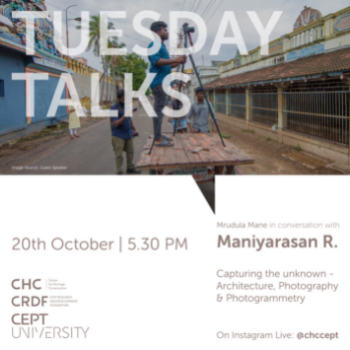Tuesday Talks: Conversation Series on Instagram Live
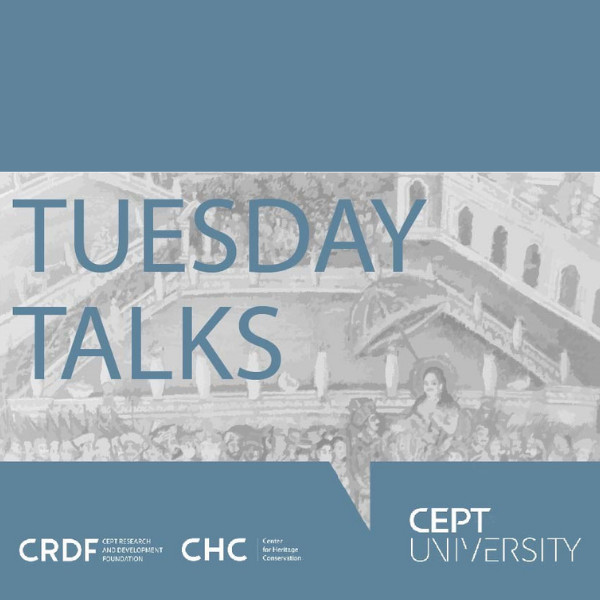
Presentations CHC
The Center for Heritage Conservation (CHC) has initiated an online conservation series with practitioners, policy makers, researchers and educators on the topic of Conservation. The series is hosted as live talks with the Center Director Jigna Desai on the Center's Instagram channel (@chccept) every Tuesday.
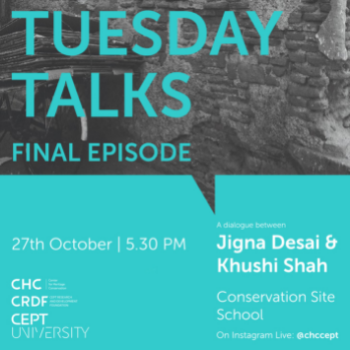
The final episode of the Tuesday Talks is an introduction to the concept of conservation site school at Tankshal in Ahmedabad by CHC. Conservation Site School is conceptually based on a premise that many heritage sites that are highly valuable for their historic importance are neglected due to the lack of active use or the lack of funds and resources. The imperative of conserving such sites and structures lies collectively among the citizens. These sites are a great repository of historic knowledge and present an opportunity for conservation training and knowledge sharing. The first site adopted for the Conservation Site School - Tankshal ni Pol Masjid, City Survey no. 603, Kalupur Ward 1 that is under the custodianship of Ahmedabad Sunni Muslim WAQF Committee (ASMWC). This structure is listed as a Grade IIA heritage site and is a rare timber mosque in urgent need of conservation efforts in the historic city. The discussion ends with a hope that the introduction of site school would increase awareness towards conservation and restoration of historic structures amongst the local community. It will serve as an opportunity for architecture students to learn the skills from the craftsmen, study the material sciences and structures on site. And most importantly as the sites will be occupied for a minimum of three years, it will give a way forward to the stakeholders and communities, an aim of reviving it!
The talk is about the speaker’s experiences and learnings in the field of architecture, photography and conservation. Photogrammetry is a method of documenting and understanding the structures and precincts through photographic images. The speaker’s expertise in this niche is the highlight of the discussion. This methodology is a recent and unexplored addition in the field of conservation and architecture. The methodology saves time required in the intense process of manual documentation. It would be ideal if the methods of photographic documentation were introduced in the architectural education at the bachelor's level. The process of using the technology gives a better insight to the understanding of existing structures. The process has certain precautions and challenges such that it requires least amount of disturbances that hinder the view points for example trees, harsh sunlight is also not desirable for the process and presence of ample time on site is essential for better results. The talk interestingly communicates that amalgamation of career choices and interests can manifest in the expertisation, which extremely helps in capacity building and contributes new technology to the field.
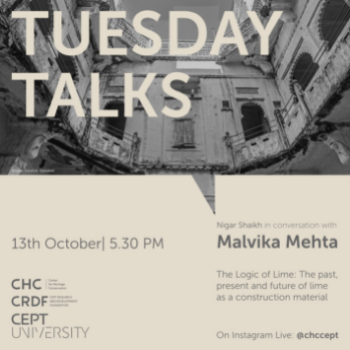
The discussion focuses on the journey of the speaker’s enterprise M-lime and her associated experiences. The talk motivates the young architects to explore and unlearn the concepts of traditional materials. The Bichli haveli project is central to the discussion, where several experiments took place to prepare the lime mix for its restoration. From the speaker’s learning on site, the past repairs and restorations need to be understood in depth to provide the solutions today. The Bichli Haveli project was helped by the VIT institute material scientists for conducting the required experiments on the lime mix. It is vital that architectural education realises the importance and significance of the traditional materials and their properties for a sustainable future and conservation of our heritage. Speaker also explicitly mentions the losing interest in cement as a material, which was in its full glory in the recent past.
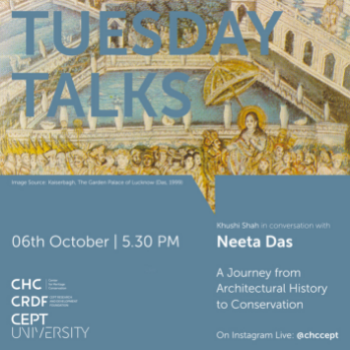
More than thirty five years of experience in the field of conservation and architectural history, this talk is a complete package of guidance, experience, challenges, knowledge and philosophical aspects of architectural history. The way history is written, perceived and importantly taught plays a major role in the understanding of timeline and architecture. Architectural history is not about mere architectural styles classified in the west and the socio-political aspects, it is about aesthetics, materials, technology, experience and associated values changing with time. The talk interestingly touches upon the differences in the philosophy of conservation and heritage in the west and in India. It also opens up new directions of thoughts towards history IN architecture, history OF architecture and history FOR architecture. To conserve and restore any structure it is of utmost importance to know and critically understand the history and its significance. The field of conservation is often misinterpreted as stagnant and anti developmental, but ideally conservation must be the present interpreting the past with an idea of future. The discussion also highlights the tradition of storytelling through which history is preserved in India, concluding with the analogy of heritage conservation with restoration of mother earth, as ‘architects should keep the building as loving as it was designed by the designer’.
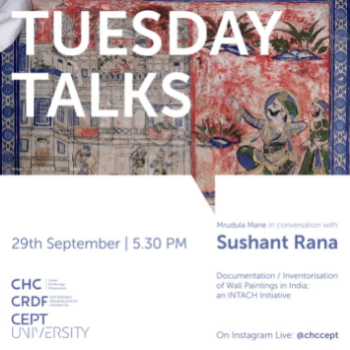
The talk is brief about INTACH's initiative for the mapping and restoration of wall paintings across India. Currently the initiative has covered seven states including Rajasthan, Uttar pradesh, Himachal Pradesh, Uttarakhand, Odisha, Delhi and Karnataka. The wall paintings need to be hundred or more than hundred years old to be a part of this initiative. One of the technicalities of the project is the in-depth classification of the art. It is important to understand the fine line difference between frescos and hand paintings on walls. In the case of wall painting restorations the understanding of the structural conditions, damages, material of the structure plays a significant role as the art is the integral part of the architecture. References are taken from the existing architectural documentation and listing of the structures, based on which the buildings are listed and surveyed for the condition assessment. Post condition assessment the pigment analysis and documentation is conducted. The publication of the book awaits, which would be a guide for the effective conservation and restoration of these unique age old wall art.
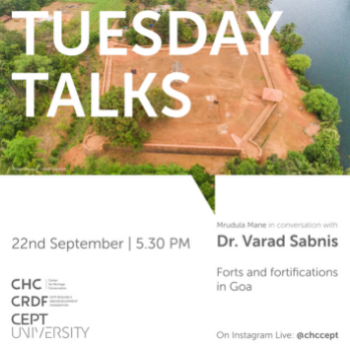
The image of forts links us to military and wars, however the forts of Goa have a different story to tell, as not all forts were constructed for the purpose of defence, many were built for trade and commerce. The region around present day Goa consisted of fifty two forts out of which thirty forts still exist. The talk is based on the history, construction and conservation of these forts. Several unique features are found in the forts of Goa, for example dry moats, angular bastians and gates in bastians. One of the most interesting features of Goan forts is the protector deity which is a semi divine entity that is believed to guard the fortified region. The discussion highlights the process and challenges faced during the restoration and conservation of goan forts by archeological survey of india. Today several of them are converted into museums, attracting travellers from around the world. The discussion also highlights that the historic structures have to be relevant to present times, as it is impossible to get the original usage.

The talk brings to the table the existence of colonial heritage over the overemphasized/well-known image of the precolonial heritage of Myanmar. Yagnon- a colonial port city is a landscape with grand row houses, three-storeyed and institutional buildings showcasing a blend of architectural styles. Heritage conservation discourse being at its nascent stage along with its political history, there is a disconnect of people to their heritage. While a lot of international educational engagement and financial assistance exist, solutions without adequate research in the local history and context have not been sustained in the long term. Apart from documentation of the building, the talk highlights conversing with the locals vital in raising awareness especially in a place where the issues of electricity persisted until recent years. The overabundance of international financial aid and the urgency to utilize it before its tenure puts forth pressure on decision-makers and leads to hasty solutions. The way forward can be the local institutional and public preparedness to a meaningful utilization of resources which can eventually lead to a promising future.
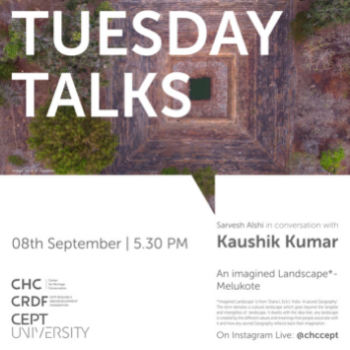
Are myths true? Did Melukote really have had more than hundreds of tanks back in time? The research on the traditional water systems and tanks of Melukote began with basic questions that led to the mapping of hundred and thirty five lost tanks which were hidden or filled in due course of time. The talk describes the journey of understanding the cultural landscapes of water tanks in a small town of Melukote, in Karnataka which is one of the four major religious sites of shrivaishav cult, along with Tirupathi, Shrirangam and Kanchipuram. There are several cultural associations which remain alive in the forms of rituals and festivals which when researched were directly associated with these water bodies. But how does one today conserve these tanks? Can associations be reestablished? What approach needs to be taken to conserve the heritage and also provide the basic developmental requirements to the locals? Were few of the questions that were addressed and worked on ground through the speaker’s research in a span of more than seven years, that still continues today. The talk concludes with a plan of preserving and saving these tanks physically, today, so there is a hope in near future to revive the traditional water systems that hold great ecological and cultural significance for the town and community of Melukote.
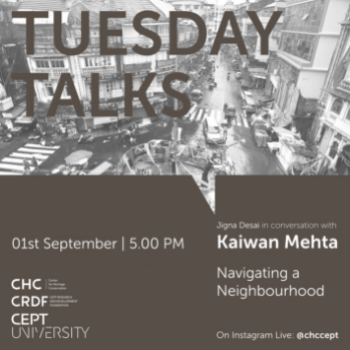
Neighborhoods in historic cities of India are diverse, negotiating, interwoven, complex and driven by the concept of coexisting. The talk interestingly encourages us to look at these neighborhood connections from an abstract lens. A lens that does not fragment and divide the typologies in the preset categories of set standard classifications. The lanes of historic cities not only have various architectural typologies as built structures but when closely observed the elements, motifs, facades, ornamentation narrates the stories and histories of migrations. It is important to understand the thin line that separates the concept of ornamentation with decoration. The discussion encourages the listener to form a story through the observations and the intangible associations with the historic structures. It is paramount to observe these associations with stylistic elements of architecture as that would develop a better sense and understanding of cultural history of a place. When the observations are linked with coexistence of neighborhoods a better and unbiased conservation approach will be developed for cities and towns.
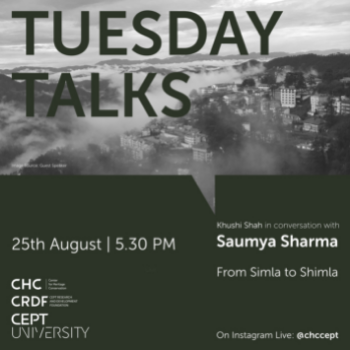
Associated memories and research on the speaker’s home town Shimla, in Himachal Pradesh, led her to pen down the concerns, in her book on Shimla. The talk focuses on the speaker’s journey in the field of conservation and observations about her own city. The city of Shimla was designed by the britishers and it served as the summer capital of British India, which led to the construction of several administrative buildings. These colonial structures set Shimla apart from other hill stations which were only occupied for leisure. Today the heritage structures face the issues of multiple ownership, lack of awareness, and over increasing tourism. Unmanaged tourism and development are leading to the loss of sense of place in the city. The thick forest cover natural landscape that envelopes the city is also greatly affected for providing the infrastructure for tourism. It is important that the government executes a management plan for heritage and tourism for Shimla, which would give a hope to conserve the serenity which was appreciated by the Britishers, that led to the birth of Shimla as a scenic hill town.

Today the majority of historic cities are crowded, congested, noisy, which develops a negligent approach towards them.The challenge is to resolve the vehicular issues without compromising the historic fabric. The most important aspect to understand here is that the historic cities were never designed for fast moving vehicles and are largely within the radius of two to three kilometres.With time we have imposed uniform traffic planning systems without understanding the fabric of the historic core. The talk highlights various questions such as - are we managing the overall traffic and vehicles or just solving the congestions? To what extent does the western model of vehicular movement be implied in countries like India? What are the paradigms of sustainable mobility? Today, we stand at a point where the planning agencies, infrastructures developers, and conservation professionals have to collectively work together by understanding the needs, significance and practicality of old cities. A dedicated public transport system specifically for the historic core is the need of the hour to prevent further loss and degradation, with improving the issues of parking, traffic and congestion.
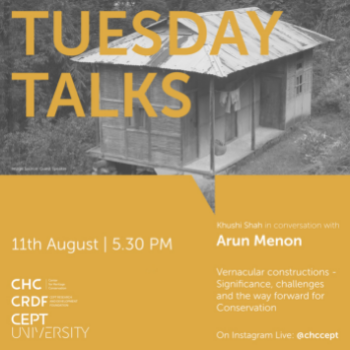
The talk focuses on the understanding the need of changing the approach towards the vernacular construction and its conservation. Vernacular is often termed as a traditional type of construction as it is owner built that adapts the local climatic and topographical conditions. The discussion interestingly put forward the point that as professionals like architects or engineers are not involved in designing the vernacular houses the typologies never got the techno legal support for conservation or even maintenance. The standardisation in the field of construction and engineering has largely affected these traditional typologies. It is the need of the hour to adopt the region specific approach involving the local community for conservation of vernacular architecture, as it is the traditional transfer of knowledge that is required to be preserved and not mere structures. The discussion brings out various examples from Nepal, Sikkim, Myanmar where the traditional typologies have survived the earthquakes and the knowledge systems have helped the communities. As professionals we need to collectively understand the common thread for the vernacular - ‘non engineered’ constructions around the world and their survival for more than hundreds of years, following the basic laws of physics.
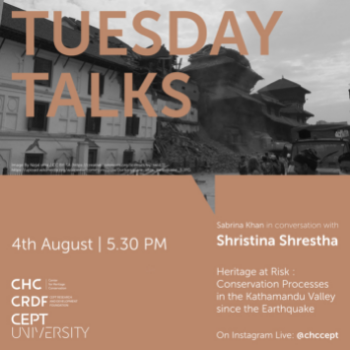
Historic structures are linked to the festivals forming a unique bond with the community living, and when traditions are continued with heritage it is termed as the living heritage.The Tuesday talk is based on the valley of Kathmandu, which has several examples of such living heritage temples, public squares, pagodas etc with unique set of architectural language formed over a period of hundreds of years and influences through the silk route. Unfortunately the area is highly prone to the occurrence of earthquakes. The conversation summarizes the loss of the prominent historic structures during the Gorkha earthquake in Nepal in the year 2015. The loss of the structures questioned the previous restorations and led to the community-led conservation approach, involving the locals. This change of approach towards repair of historic structures revived the older methodologies in construction and tendering. The case of Kathmandu’s community participation in conservation sets an example of hope in front of the world. The talk highlights several interesting aspects of this unique approach adapted by the municipality, people and architects of Nepal. Being the land of recurrence of earthquakes, the method of reconstruction in Kathmandu handovers the techniques to the next generations which should be seen as a way forward in understanding conservation in South asia.

The unique title of the talk by the speaker is a reference from a Berlin band protest related to the first occupied house in czech, which is known as Georg-von-Rauch Haus. The track "Rauch-Haus-Song" describes the scenes when the police attempted to evict the squatted Georg-von-Rauch-Haus in December 1971. The house was the part of the former Bethanien hospital, and was the first house which was squatted in Berlin. The title here depicts the scenario of heritage structures when they lose their economic value, and are dismantled. The song has the words -’unsa haus’ which indicates that this is our home now, and no longer a part of the hospital. It links to the question of what do the old buildings present to us as opportunities, new forms of work - live relationship and regeneration. The talk sets a dialogue with Berlin as an example of how comprehensive redevelopment changes a city that gives a dramatic shift to the building typology, heritage and culture.
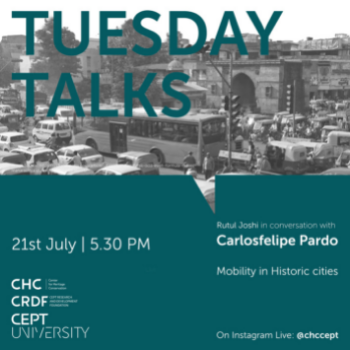
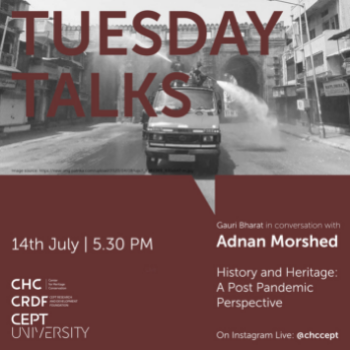
Covid-19 pandemic altered several perspectives towards life, environment and human existence. It has also made us question the health care systems across the globe. This Tuesday talk revolves around the relationship between the historic built spaces and the occurrence of pandemic. The discussion drew parallels between the ‘black death’, plague pandemic that occurred during the fourteenth century across Europe and the current pandemic of Covid-19. Though the questions are still unanswered, the parallels between the older outbreak of diseases, indicates social changes and revolutions. As observed after the great plague, a large number of people lost their faith in church that led to a social change in Europe. The talk concludes with the need to invest in the public health sector. And understand the difference between density, congestion and chaos, to build the health infrastructure and pandemic preparedness better. There is the question left to be answered, for the future, what will be the impact of the pandemic on the architectural sense of place and designing.

The terms ethnicity and culture are largely associated with the national identity of a country. The talk is an interdisciplinary interaction between a political science expert and a conservation architect, predominantly focused on the central Asian region of present-day Uzbekistan. The talk discusses the top-down approaches of nation building predominantly seen in the countries which did not have any movement for independence. And in this process of building national identity the role of culture, old structures and history plays the essential part. Either the negatively associated architecture is knocked down or the newer structures are constructed ‘looking similar’ to the traditionally identified building styles. Positively today several nations that share the same geo cultural identity are coming together with MOUs for exchange of art, festivals and language. As the talk is interdisciplinary, it brings out the need for an multidisciplinary approach towards political policy making between nations and states for a better understanding and peace.
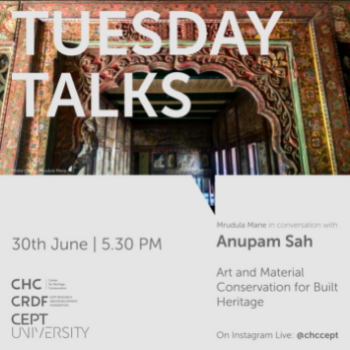
The talk gave an insight to the practical aspects of material conservation in built heritage. The materials present in a historic structure can be either a part of the structure for example the paintings, frescos or carvings on the walls, or they can be objects like curtains and carpets. Thus, the field of material conservation is elaborate and diverse. It is important that for the conservation or restoration projects the art conservators are consulted at every stage of the intervention to avoid damage to the significant built/unbuilt elements of the structure. The talk also pointed out the challenges faced in the field of conservation in India, such as lack of organisation of workspaces, health and safety issues, and improper tools for working in situ. The talk concludes with the hope of change in the professional practise of art and building conservation that would involve effective community participation, proper sharing of knowledge resources, better interactions between the craftsmen and the architects.
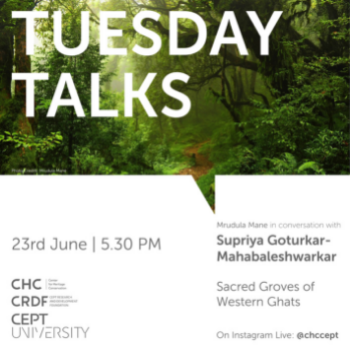
Human survival is only possible through ecological conservation and a sustainable lifestyle. Our ancestors realized the importance of forests and their micro-ecosystems around 10,000 years ago. The protection of a patch of forest in the name of the deity is termed as the sacred grove. All over India researchers believe that currently there must be one lakh sacred groves. The concept of sacred groves is a link between the community, their belief systems, and mother nature. The communities predominantly the tribals are dependent on the forests for their livelihood, and hence the protection amalgamating with the cultural practices emerged. But today with the wish of moving to the larger urban areas has resulted in the vanishing of these biodiversity hotspots. The talk concludes the importance and need for the community-led conservation of these sacred groves as they are at the peak point of extinction if nothing is done now. It was suggested that people from different fields and domains like education, forest departments, anthropologists, botanists, heritage experts, etc should come together for the protection of the groves and saving the future. Also, the best guideline to protect nature and ecosystems is to not do any intervention and let it be on its own, as nature finds its way.
.jpg)
The ‘World Heritage City of Ahmadabad’ is one where the city’s architecture is formed through a complex layering of multiple actors accumulated over time while ‘Adivasi’ heritage is discussed through the ‘Santals’ known for their precise architectural practice of traditional mud houses. The challenged notion of elitist history and the role of conservation display a complex continuum of the heritage site’s engagement and negotiation with the time, place, and politics it lies within. With the dominant narrative of alienation of land and dispossession due to industrialisation, heritage discourses are beneficial to ‘Adivasi' communities when mobilised for sustenance or political agency. Discussions within the talk extend from the contestations of dominant and marginalised voices in shaping the site's cultural identity to the power dynamic that heritage tags embody in relation to the experiences of communities living within these sites. The question of a shift/deepening of heritage narratives once various agencies enter the discourse reveals a complex scenario. The talk concludes with a discussion on the need for the cultural translation of words to further the local communities' engagement in defining their cultural identity.
.jpg)
Imagined to be the ‘conductor of an orchestra’, the multidisciplinary nature of the Conservation Architect’s profession is highlighted in this talk. From being a scientific expert of urban, architectural, and material studies, the Conservation Architect’s skill extends to a community-led model with authenticity, sensibility, sensitivity, and morality mounted in its center. Recognising that local communities are the custodians of heritage properties, the skill of empathy facilitates a process of collaborative practice between the contractor, architect, client, and craftsmen. The talk further extends to the process of legislation in conservation practice, holistic representation through recording the imperfections of the process, looking at lime as a ‘daal’ unique to every household, the contextual response of conserving against rebuilding, and the responsibility of creating good architecture against mediocre architecture attempting to simply stick in or stick out. The talk concludes with addressing the ‘nostalgia bias’ which is argued to be the biggest mindset in the profession of conservation, where one romanticises the past forgetting its problems and complex layering.
.jpg)
Starting with an overview of opportunities that young conservation architects encounter, this talk extends to discuss the techniques and softwares that emerging professionals bring into the discipline, the dilemma of principles learnt in education against its practical functioning on-site, and the role of organisations like the ICOMOS ‘Emerging Professionals Working Group’. The realities of emerging professionals are conveyed through discussions on the 'migratory syndrome' of being educated abroad, the power of networking and collaboration, the passion of emerging professionals, challenges faced through communication gap between the peers, and the advantage of mentorship from senior expertise of the fraternity. The talk ends with conveying the importance of an emerging professional to keep the company of economists, IT professionals, social workers, engineers, and individuals with development agencies. The importance of reducing the communication gap within peers, working collaboratively and through collectives to be supportive of each other, the synergy of conservation and development, and the passion to fight for culture and art conclude this engaging discussion.

Acting as a repository of culture, the project started in Ladakh as a pilot project to explore the dimension of community and extended to eighteen sites encompassing professional training workshops, community awareness workshops, and documentation of the site's intangible and tangible heritage. The project is seen through a dual lens of empowering the researcher to understand the community’s heritage values while enabling the community with the power of interpreting their heritage, roots, and cultural identity through a museum. The talk further explores discourses on the differences between a community-initiated museum and a more formal institution, the question of de-contextualisation of the object, the role of heritage documentation in relevance to the contemporary lives of the community, and the dynamics and politics of the community’s cohesion through the role of women. Stories of the curatorial process, the community’s need to showcase their knowledge systems, the involvement of children, and the future trajectories of the project through growth and management further strengthen and display the complexities of this project.
.jpg)
In light of the ‘Covid-19’ pandemic, this talk discusses cultural heritage's vulnerabilities through high-density historic cities emerging as hotspots, the threat to the livelihood of craftsmen, the lack of staff and economic incentives, and the challenges of multiple hazards and the adaptive reuse of heritage structures for the purpose. Psycho-social support through online platforms, templates for the assessment of risks and needs, guidance on the closure of heritage sites, strategies for business continuity, the importance of stories of people's resilience, and the use of traditional knowledge systems strengthen the role of cultural heritage. The talk includes discussions on the decongestion of the city without risking its heritage, disinfectants affecting the structure's fabric, strategies supporting artists and craftsmen, and the challenges in adapting to a ‘post-Covid’ world. Participatory processes in decision making, the pandemic's short and long terms effects, and the opportunities presented by the digitisation of heritage strengthen the narrative. The talk concludes with the larger virtue of conservation extending beyond preservation and repairs to a narrative interconnected in people's lives with collaborative efforts of scenario-based thinking linking conservation to development.
.jpg)
From the city’s origins to the recognised values of cultural exchange seen through neutrally accepted norms of community living, the outstanding example of a traditional human settlement, and the lifestyle of the city through its tangible and intangible cultural heritage, form part of its ‘World Heritage’ nomination. The case of the living city extends from conservation of heritage to economics, administration, development, and prevailing lifestyles. The talk discusses the city administration’s history and the structure of the Ahmedabad Municipal Corporation with its associated bodies facilitating the city’s management. Ahmedabad World Heritage City Trust’s involvement extends from documentation to guidelines of conservation, incentives for heritage properties, and tackling the challenges of gentrification, changes in community structure, and property owners’ notion of fearing heritage. The talk concludes with discussions on the perspective of managing a city through the pandemic, tackling the smuggling of historically valuable elements, the unique advantage of traditional timber-framed construction, and the importance of identifying a city’s language without freezing its development.
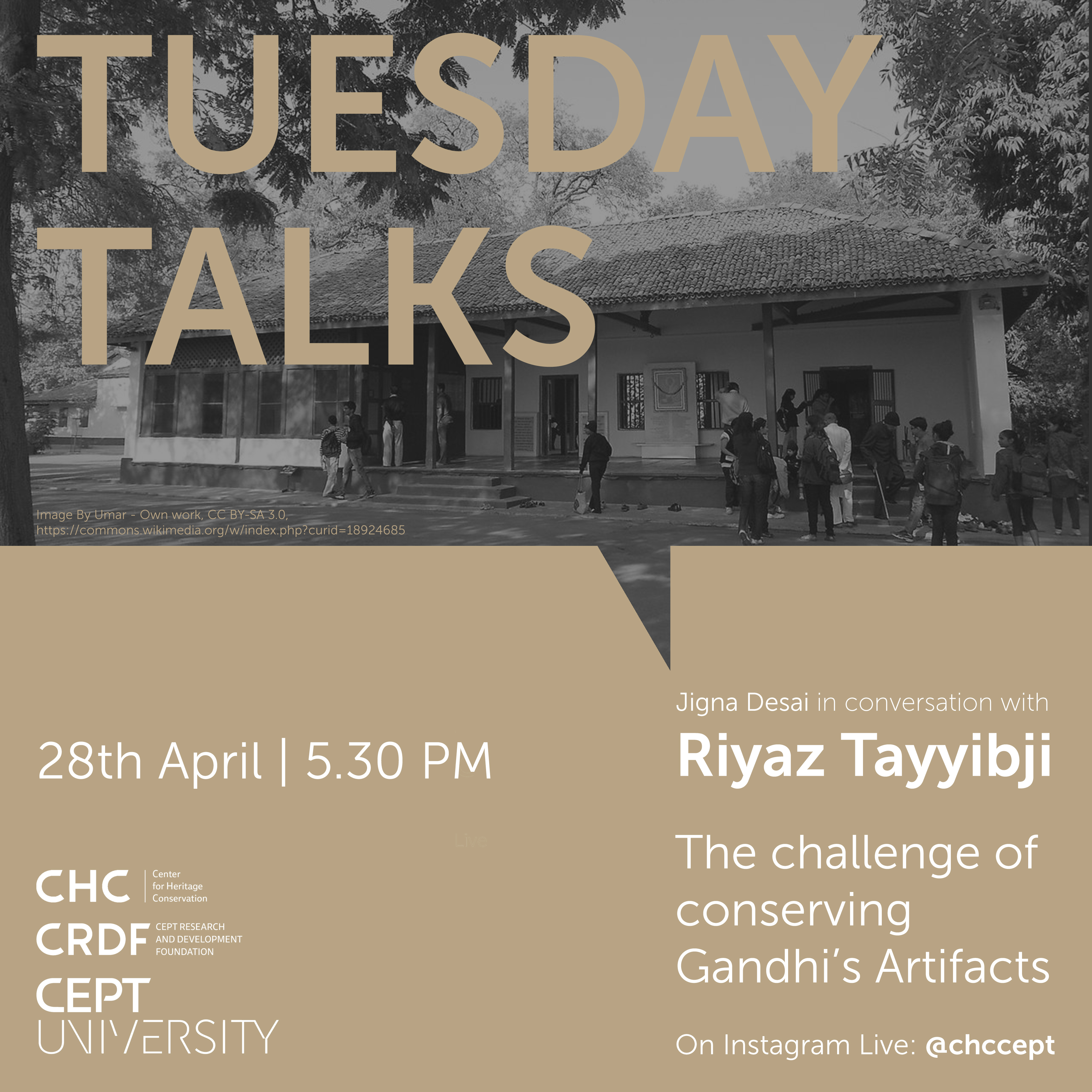
Drawing parallel connotations of conserving Gandhi’s bicycle, the talk begins with the question of recording heritage of a man who prioritized the process involved over the artefact itself. Decisions of conservation affecting the sense of place, the relevance of conserving Gandhi’s heritage without it turning into pure symbology, and Gandhi’s ideology of scale observed through the bicycle’s joineries, details of the ‘charkha’, and the very idea of building a nation form the crux of this discussion. Gandhi’s ideologies affecting conservation of the built environment are explored through the ‘relationship of making’ and philosophies of architecture reflecting in program, activity, use, behaviour, ethics, morality, and materials. The pragmatic approach on originality against the contextual availability of materials is discussed to be the hook around which conservation navigates its practice. The talk concludes with the question of authenticity mounted in the question of whose heritage and what use. The importance of historicity of a particular narrative against the focus of valorised use raises complexities in understanding its authentic value.

This talk explores the cultural narratives of the city’s historical evolution. The city’s narrative begins with the ‘gurus’ of the Sikh faith by understanding their cultural trail through geographical relationships. From the settlement developing around the sacred shrine of ‘Harmandir Sahib’ in the city’s water tank to major reconstruction of the city’s architecture and formation of the ‘bungas’ in the mid 18th century, French influence on the architecture of the city through Maharaja Ranjit Singh, and the British realigning the ‘Mughal Imperial Highway’ to include the city of Amritsar, the city’s evolution of architectural style, urban design, and geopolitical influences are elaborated upon. With the co-existence of tangible and intangible heritage, important questions of the degree of their intersection, methods of intervention, and the selection of actors within that participation form fundamental discourses to be deliberated upon. The talk concludes with a quote on ‘calibrating reform and repression’ as a tool for conservation architects to objectively look at violent pasts and the trajectories forward.
